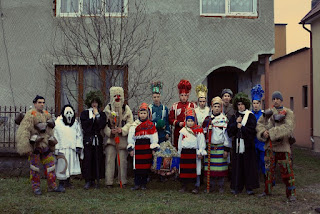 |
| Copyright Felicia Simion |
Bucharest-based photographer Felicia Simion features in The Royal Photographic Society’s April 2020 Journal ‘In Focus’ section (p. 228), with a photograph of a nativity-themed play (which I notice is slightly cropped) taken in Breb. It is accompanied by a brief interview discussing her project ethnographies, charting aspects of rural Romanian folklore and customs which are gradually disappearing.
She revealed that the idea arose
during her study of cultural anthropology, ethnology and folklore, when she
decided she was less interested in the past than in how such customs interact
with a changing culture. The result is a
fascinating insight into longstanding traditions while conveying a sense of their
fragility in the face of modernity (a tension perhaps exemplified by the child
wearing a Scream mask).
Simion has said in interviews
elsewhere that the desire to become a photographer originated in her discovery
of the Magnum agency at the age of 13.
Although still only in her mid-twenties, she has already produced a wide
range of images in both colour and black and white, has gained a huge number of
awards, and been widely exhibited and published. She balances commercial work (book covers,
fashion) with documentary and art photography.
As well as in Romania, where the
accompanying text on her website describes with affection the village in which she
grew up and her relatives living there, she has photographed in France, South
America, and surprisingly on the Bluebell Line in Sussex. Just as easily her camera can turn inwards,
as when her body in pregnancy became her subject. She is comfortable with both realism and
fantasy, sometimes photographing herself in colourful body suits which render
ordinary locations uncanny, but has a particular talent for portraiture,
especially women’s faces.
It’s a shame the RPS could not have
afforded Simion more space to showcase her versatility but the piece does
include a link to her website, which should widen her audience still further.
Update 10 September 2022:
‘Photographer Suffering From
Postpartum Depression Uses Her Camera to Find Herself Again [Interview]’
A short interview with Felicia
Simion appeared on the My Modern Met website, dated 29 August 2022. Staff editor Sara Barnes asked her about how
photography had performed a healing function in her recovery from postpartum
depression. Feeling alienated from the
countryside at home, she took herself off to Iceland for the project which
became Rewired (2022) and featured Simion entangled in yards of woolen yarn
– red, yellow and blue – a soft warm curved body contrasting with the hard cold
angular, but beautiful, terrain.
Despite cutting an isolated figure,
dwarfed by her surroundings, she says the act of tying herself to the bleak
landscape made her feel alive. It was a
healing experience, though one might characterise it more as shock therapy, the
uncomfortable act of physically linking herself to the natural world acting to
refresh her relationship with it. It may
not be the sort of treatment that is for everyone, but it worked for her, and
resulted in a memorable set of images.
Asked to describe her work, she
replied it is ‘Eclectic. Real and surreal at the same time,’ and Rewired,
the title of which says it all, accurately fulfils that description. She mentioned at the end that her next
project will concern environmental issues in a southern Romanian village, proof
that she is once again at home in the countryside of her homeland after her
sojourn in a place that could not be more different.
Simion talks about Rewired
on her website. She is also running a
project in which she invites others who are suffering or have suffered from postpartum
depression to get in touch in order to share their experiences.
